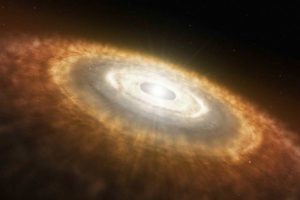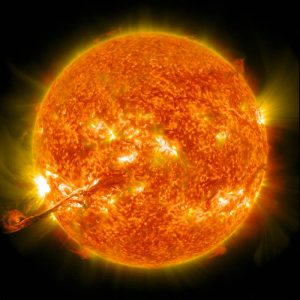The Solar System – the Solar System – is a planetary system consisting of the host star the Sun and surrounding celestial bodies, which are linked together by gravity. The Solar System lies at the edge of a galaxy called the Milky Way, located about 26,000 light-years from the galactic center.
Our solar system is moving around a giant black hole at the center of the galaxy at a speed of more than 720,000 km/h. It is estimated that one revolution of the Solar System around the galaxy takes up to 230 million years and since its formation it has completed about 18 revolutions of the galactic center.
Formation
Our Sun and Solar System formed about 4.5 billion years ago from a dense cloud of gas and rock dust from the Big Bang. As these dust clouds approach each other, they will begin to bear their own gravity and shrink, forming a solar nebula – a swirling disk of matter that attracts everything around. At the center, gravity pulls more and more matter in, the pressure in the core is so great that nuclear reactions occur, hydrogen atoms begin to combine and form helium, releasing a tremendous amount of energy. That is how our Sun was born and stored fuel to operate to this day.
The Sun formed from a dust cloud left over from the Big Bang. Photo: NASA/JPL-Caltech.
Structure of the Sun
The Sun is the largest and most important object in the Solar System. Without its existence, our planet would not be able to have life as it is today. The Sun is about 150 million km from the Earth, its diameter is nearly 1.4 million km, 109 times the diameter of the Earth, from which it can be inferred that its volume is nearly 1.3 million that of the Earth, which means it takes 1.3 million Earths to fill the Sun. This star also rotates on its own axis, at the equator it takes 25 Earth days and at the poles takes 36 Earth days.
The Sun is a plasma sphere, a giant superheated nuclear reactor, its main composition is Hydrogen (73%) and Helium (24%) and other elements such as ,C,Fe,S, Si,N,Mg,… Because the Sun is so massive and its gravity so strong, the hydrogen atoms near the Sun’s center – at its core – are under tremendous pressure, and are squeezed. very close together. Four of these atoms are squeezed together so tightly that they stick together forever, forming a new, larger, and more complex atom: helium. This process is called nuclear fusion, and when it happens, huge amounts of energy are released in the form of heat and light. Every second, nearly 5 million tons of matter are converted into energy, this energy is transferred from the core to space by radiation.
The Sun is a ball of plasma that boils at extremely high temperatures.
The hottest part of the Sun is its core, where temperatures up to 15 million degrees Celsius are hot enough to sustain nuclear fusion. The deeper into the core, the denser the matter, the plasma state gradually turns to solid and evenly distributed from the shell to the core. The activity of the Sun, from its powerful eruptions to the steady stream of charged particles it produces, affects the nature of space throughout the solar system.
The Sun does not have a solid surface like Earth and other rocky planets. The gas that surrounds it is about 250 miles thick, with temperatures up to about 10,000 degrees Fahrenheit (5,500 degrees Celsius), much cooler than the core, but it’s still hot enough to make carbon — like diamond and graphite — not only melt but even boil.
The end of the Solar System
The Sun is now a middle-aged star, it has been around for about 5 billion years and will continue to shine, almost unchanged for another 5 billion. When it runs out of fuel in its core, and fusion will stop. Once this happens, the core will contract under its own gravity, until it becomes denser. These collisions produced much more energy than the hydrogen fusion that powers the Sun today. The excess energy will cause the core to become hotter, the Sun will swell to more than a hundred times its current size and swallow Mercury and Venus. At this stage it will become a red giant. As the Sun expands, the Earth, even if it is not swallowed up, will become lifeless, the oceans will evaporate, and the atmosphere will be blown away.
Meanwhile, the helium-burning reaction will create stronger-than-normal solar winds, which will blow away hydrogen at the surface and form nebulae. The more matter that is carried away from the Sun, the stronger the solar wind will be and blow away most of its matter. At this point, the pressure at the core is not enough to sustain the helium reaction, the Sun will face its own gravity, shrinking a white dwarf and leaving behind a thin layer of glowing dust known as a nebula. This will happen in about 10 billion years.
According to the Universe in a Chestnut Shell and A Brief History of Time by Stephen Hawking.

